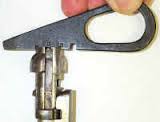
Be certain to check the firing pin protrusion using the screwdriver / protrusion tool found in the Mosin Nagant Cleaning kit.
IMHO, if you do not have this tool, buying the entire cleaning kit is well worth the money. Some unscrupulous vendors have replica tools that are not to spec.
Consequently, they do not accurately measure protrusion.
I have never heard of a replica tool being sold as part of a surplus kit.
Why Bolt Protrusion is Important
If the firing pin does not protrude far enough out of the bolt the gun will not fire. Alternatively, if it protrudes too far it can puncture the primer. This will cause hot combustion gasses to leave the bolt and move into your face.
Either of these situations can be extremely dangerous and are not part of the enjoyable use of your moist nugget.
How to Check Protrusion
- First, Verify that the bolt is in its “fired” position and that the firing pin is flush with the cocking piece.
- The index marks must be aligned.
- Second, the firing pin must (at least) touch the top of the milled out area below the number “75” on the protrusion gauge.
- If it does not, firing pin protrusion is insufficient. Be certain that there is no gap between the bolt head and bolt body (hold them together) when performing this test.
- Finally, the firing pin must not touch the top of the milled out area under the number “95”. If it does, firing pin protrusion is excessive.
 If you do not have the teardrop shaped too you should order one. However, if you have a caliper, the firing pin must protrude at least .075 inches. Additionally, it cannot exceed .095 inches.
If you do not have the teardrop shaped too you should order one. However, if you have a caliper, the firing pin must protrude at least .075 inches. Additionally, it cannot exceed .095 inches.
Generally speaking, a matched bolt should not have a protrusion problem. This is assuming the firing pin and the cocking piece are flush and the index marks are aligned. I would be suspect of a private sale that had protrusion problems. Personally, I would wonder if it was pieced together from various guns.
Finally, you can adjust firing pin protrusion by turning the firing pin in the cocking piece.
The bolt will have to be disassembled (or cocked) because there is a notch that normally prevents the firing pin to rotate and change protrusion.
Usually having the rear end of the firing pin flush with the back of the cocking piece gives you the correct adjustment.

